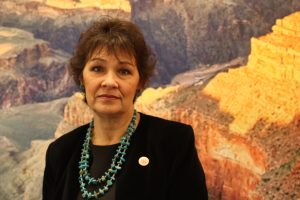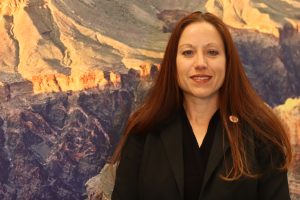By KELSEY MO
Cronkite News
SELLS – One day they were there and the next they weren’t. No one talked about the Native women and girls who simply disappeared.
April Ignacio knew they existed. She did not forget.
How many were there?
Nearly three years ago, she started a quest to help others recount how many of her Native sisters disappeared.
Ignacio talked to fellow members of the Tohono O’odham Nation and began listing women who had gone missing or were murdered in her community. She pored over newspaper archives. Word of her inquiries spread and the project picked up speed.
She tried working with tribal police and the tribal prosecutor’s office, asking whether they could remember cases in which women were missing or murdered. Some retired officers told her they didn’t want Ignacio “kicking over these types of rocks.”
She spoke with family members of the lost women, building a catalogue to track them.
“That was the hardest part of doing something of this magnitude,” Ignacio said, recalling a mission that began in July 2016. “It’s still a very sensitive subject for a lot of small communities.”
One woman. Four women. Then more.
So far, at least 33 women, stretching back to the 1960s, are on the list.
Limited data exist on the number of missing and murdered indigenous women – one account recorded 506 cases in 71 urban areas – but experts say it’s likely undercounted because authorities inconsistently collect data. A bill in the Arizona Legislature would establish a committee of community leaders from tribes and police departments to officially track and analyze missing and murdered indigenous women.
Legal issues surrounding violent crime on reservations further complicates the issue. Native American tribes, under federal government law, have limited jurisdiction to indict and sentence defendants in tribal courts. Sometimes, cases are sent to federal court. Figuring out whether the federal or tribal courts have jurisdiction to prosecute violent crimes can drag out cases for years.
Advocates say the process often leaves behind questions for the families and perpetuates historical trauma.
A quagmire of legal jurisdiction
Some reservations are so vast that officers have to travel hours before they secure a crime scene and begin the investigation. If the case falls under the federal Major Crimes Act, it may take even longer for FBI agents, who are generally stationed in larger cities, such as Flagstaff, Phoenix and Tucson, to get there, said attorney Albert Hale, a Navajo and former Arizona legislator.
He said figuring out where and how criminal cases are processed depends on whether the perpetrator and victim are Native American, if the crime happened on a reservation and if it falls under federal jurisdiction, which would bring in the FBI.
If the perpetrator and victim are Native American, the case usually goes to a tribal court, Hale said.
Murder, manslaughter and child abuse fall under federal jurisdiction, which can prolong the prosecution.
Hale said it could take two years from when the crime was committed to when the trial begins. In that time, witnesses may die and memories may fade. And when the case gets to trial, where the experience is impersonal and possibly miles from the reservation, it’s a foreign system to Native Americans, Hale said.
Federal officials sometimes decide not to take the case, which then goes to tribal court. But those courts have limited sentencing options.
In certain criminal cases, the Native American court can only impose a maximum three-year sentence, according to the 2010 Tribal Law and Order Act of 2010. And, Hale said, there are limited detention facilities on tribal lands, so prisoners often are released early. By comparison, a defendant convicted of second-degree murder in Arizona state court faces up to 25 years in prison.
“What kind of punishment is that?” Hale asked. “That’s, again, federal intrusion on the sovereignty of the Indian nation and making Indian nations limited or less powerful in terms of dealing with crimes that are committed on the Indian reservation. They get prosecuted elsewhere and the community is left to suffer there.”
He called it a continuation of Native communities’ “historical trauma.”
Little attention, little data
Not all cases of missing and murdered indigenous women occur on tribal land. About 70 percent of American Indian and Alaska Natives live in urban areas, according to an Urban Indian Health Institute study that reported 506 cases across 71 urban cities in America.
The actual number of missing and murdered indigenous women is uncertain. Lack of resources, poor data collection in urban areas and racial misclassification, among other factors, affect the count, the study says.
Arizona ranked third for the highest number of missing and murdered indigenous women cases among the states studied, and Tucson has the fourth highest number of missing and murdered indigenous women in the country out of the cities studied.
The National Institute of Justice released a study in 2016 that showed 4 out of 5 American Indian and Alaska Native women have experienced violence in their lifetimes.
‘At least I can help somebody else’
Activists are fueling a sense of urgency around the issue. Indigenous women led the Women’s March in Phoenix earlier this year, advocating for their missing sisters who no longer have a voice.
Indivisible Tohono, activists who raise awareness of Native American issues such as missing and murdered indigenous women, holds regular meetings at a Shell gasoline station to strategize.
Anthony Francisco, who serves on the Tohono O’odham Legislative Council, said the violence against their sisters exposes the hurtful and harmful aspects the community wants to overcome. He added it’s difficult to address an issue as sensitive and negative as missing and murdered indigenous women.
“Some of the leaders, they don’t want that exposure in that way,” Francisco said. But the group’s mission is not to “expose” but to take action. Some members of the group have traveled to the Arizona Capitol in support of legislation and hosted a panel of discussion on #MMIW, the social media hashtag for missing and murdered indigenous women.
Audrey Ramon, who attended a recent Indivisible Tohono meeting, said she lost her mother to domestic violence in 1990 and advocates on her behalf.
“I can’t bring her back, but at least I can help somebody else,” she said.
Ignacio, the group member who started the private database, said she’s learned how sensitive she needs to be when talking to families who have experienced trauma. Documenting missing women is a heavy topic, she said, and there’s tension between making sure these stories are told and respecting the families who may not be ready to share.
But not acknowledging the problem perpetuates the violence generations of Native Americans have endured, Ignacio said. Indivisible Tohono works to prevent and acknowledge the violence, whether it’s trying to fix an underfunded domestic violence program or pressuring lawmakers to care about indigenous women.
Arizona bills to end ‘epidemic of violence’
Rep. Jennifer Jermaine and Sen. Victoria Steele, Democrat lawmakers, proposed identical bills that would establish a committee of tribal and non-tribal leaders, and others, to track and analyze data on missing and murdered indigenous women.
House Bill 2570 and Senate Bill 1253 would require the committee to conduct a study to determine how to reduce violence, identify barriers to providing more state resources and propose culturally appropriate victim services.
Steele, a Tucson lawmaker, said this bill is meant to create an understanding of what’s happening and that this issue was adding to the generations of traumatic experiences.
“They’re disappearing not once, but three times. In life, in the data and in the media,” Steele said. “We can’t allow our Native sisters to just disappear at this rate and not draw attention to it.”
At a House Health and Human Services committee hearing, Jermaine, a Phoenix lawmaker, called the lack of data appalling.
“We have the opportunity to bring their stories to light and to move towards meaningful change to end this epidemic of violence,” she said.
Ignacio and several other Native Americans also testified in support of the House bill, which the committee voted unanimously to move forward.
When Rep. Nancy Barto, chair of the House Health and Human Services committee, announced the final vote, some women who testified clasped their hands. Some sobbed.
Have a story idea? Email us at cronkitenews@asu.edu.
For more stories from Cronkite News, visit cronkitenews.azpbs.org.
^_=



